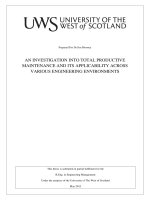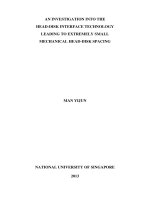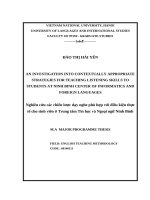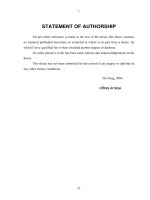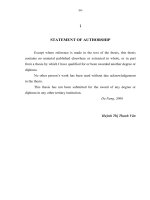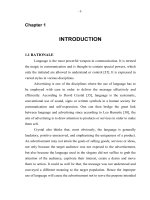Textbook evaluation an investigation into vectory 01
Bạn đang xem bản rút gọn của tài liệu. Xem và tải ngay bản đầy đủ của tài liệu tại đây (3.09 MB, 135 trang )
MINISTRY OF EDUCATION AND TRAINING
HO CHI MINH CITY UNIVERSITY OF TECHNOLOGY
---------------
VO QUOC DAI
TEXTBOOK EVALUATION: AN
INVESTIGATION INTO VECTORY 01
Submitted to the
Faculty of English Language
in partial fulfillment of the Master’s degree in English Language
Course code: 60220201
HO CHI MINH CITY, March /2018
CERTIFICATION OF THESIS DEFENSE
THE THESIS WAS WRITTEN AT
HOCHIMINH CITY UNIVERSITY OF TECHNOLOGY
Academic supervisor’s name : Dr. Nguyễn Thanh Bình
The thesis defense session was conducted at Hochiminh City University
of Technology (HUTECH) on April 6th, 2018.
The Board of Examiners for the Master’s Thesis Defense
TT
NAME
FUNCTION
1
Dr. Nguyễn Thị Kiều Thu
Chair
2
Dr. Phạm Nguyễn Huy Hoàng
Reader 1
3
Dr. Lê Văn Tuyên
Reader 2
4
Dr. Nguyễn Đăng Nguyên
Member
5
Dr. Lê Thị Thanh
Secretary Member
On behalf of the Board of Examiners
Chair
Nguyễn Thị Kiều Thu, Ph.D.
HCMC UNIVERSITY OF TECHNOLOGY
HCMC, May 2, 2018
POSTGRADUATE INSTITUTE
MASTER’S THESIS TASK REPORT
Student name: Võ Quốc Đại
Date of birth: December 11th 1985
Major: English Language
Sex : Male
Place of birth: Ho Chi Minh city
Student code: 1641900005
I- Thesis title:
Textbook Evaluation: An Investigation into ‘Vectory 01’
II- Task description and contents:
This research study evaluates Vectory 01, an official textbook used for students
in an English Center in Hochiminh City, Vietnam. The empirical evaluation was
conducted based on data collected from 50 teachers and 104 students at Vectory
English Center in the form of questionnaires and semi-structured interviews. The
purpose of the study is to find out the users’ views on the textbook, its impact on users
and the users’ recommendations for improvement.
III- Starting date: August 1st, 2017
IV- Completing date: April 6th , 2018
V- Academic supervisor: Dr. Nguyễn Thanh Bình
SUPERVISOR
Nguyễn Thanh Bình, Ph.D.
FACULTY DEAN
Nguyễn Thị Kiều Thu, Ph.D.
CERTIFICATE OF ORIGINALITY
I certify my authorship of the Master’s Thesis submitted today entitled:
TEXTBOOK EVALUATION: AN INVESTIGATION INTO VECTORY 01
In terms of the statement of requirements for Theses in Master’s programs issued by
the Higher Degree Committee of Faculty of English Language, Ho Chi Minh City
University of Technology.
Ho Chi Minh City, March 2018
VO QUOC DAI
i
RETENTION AND USE OF THE THESIS
I hereby state that I, VO QUOC DAI, being a candidate for the degree of Master of
Arts (English Language) accept the requirements of the University relating to the
retention and use of Master‟ s Theses deposited in the Library.
In terms of these conditions, I agree that the original of my Master’s Thesis
deposited in the Library should be accessible for purposes of study and research, in
accordance with the normal conditions established by the Librarian for the care,
loan, and reproduction for theses.
Ho Chi Minh City, March 2018
Signature
VO QUOC DAI
ii
ACKNOWLEDGEMENTS
I am deeply indebted to a number of people and organizations in the process of
conducting this study. I would first like to express my deepest gratitude to Dr.
Nguyen Thanh Binh, my supervisor, for his patience, guidance, insightful advice,
and constant encouragement through the whole research process. Without his
support, excellent feedback and guidance, this thesis would never have been
completed.
I also greatly thank Dr. Nguyen Thi Kieu Thu for her continuous support and
guidance whenever I need any advice.
I am grateful to Mr Le Quang Minh, manager of Vectory English Center (Trung tam
Anh Ngu Toan Tam) for permission and great support to conduct the research at the
center.
And finally, I would like to sincerely show my gratitude to all the participants who
directly or contributed much data to this study.
iii
ABSTRACT
This research study evaluates Vectory 01, an official textbook used for students in
an English Center in Hochiminh City, Vietnam. The empirical evaluation was
conducted based on data collected from 50 teachers and 104 students at Vectory
English Center in the form of questionnaires, semi-structured interviews. The
purpose of the study is to find out the users’ views on the textbook, its impact on
users and the users’ recommendations for improvement.
The results of the evaluation show that the textbook is suitable to the teaching and
learning context and culture; it offers much help to both teachers and students; it
also receives positive feedbacks from teachers and pupils.
Apart from these merits, Vectory 01 needs to be improved in varying types of
activities, providing free practice activities after the controlled ones, supplementing
the textbook with language material from different resources such as picture stories,
comic strips, etc. and providing the supporting resources
The findings also indicate that textbook writers should carry out learner needs
analysis before writing new textbooks to make sure they meet learners’ needs.
Key words: ELT; Textbook; Textbook evaluation
iv
TABLE OF CONTENTS
Page
Certificate of originality .............................................................................................. i
Retention and use of the thesis ....................................................................................ii
Acknowledgements ................................................................................................... iii
Abstract ...................................................................................................................... iv
Table of contents ......................................................................................................... v
Appendices ................................................................................................................. ix
List of tables ................................................................................................................ x
List of abbreviations .................................................................................................... x
CHAPTER 1: INTRODUCTION
1.1 Background to the study........................................................................................ 1
1.1.1.The importance of English in Vietnam ................................................... 1
1.1.2.Governmental Policies towards EFL in Vietnam ................................... 2
1.1.3.ELT at English Centers in Vietnam ........................................................ 4
1.2 Problem statement ................................................................................................. 4
1.3 Research questions .............................................................................................. 4
1.4 Purpose of the study .............................................................................................. 5
1.5 Scope of the study ................................................................................................. 5
1.6 Significance of the study ....................................................................................... 6
1.7 Organization of the thesis...................................................................................... 6
CHAPTER 2: LITERATURE REVIEW
2.1. Introduction .......................................................................................................... 7
2.2. Definition of Textbooks in EFL ........................................................................... 7
2.3. Arguments about the roles of Textbooks in EFL ................................................. 7
2.3.1. Advantages of Textbooks....................................................................... 7
2.3.2. Disadvantages of Textbooks .................................................................. 8
2.4. Textbook design ................................................................................................... 8
2.5. Textbook evaluation ........................................................................................... 13
2.5.1. Definition of Textbook Evaluation ...................................................... 13
v
2.5.2. Roles of Textbook Evaluation ............................................................. 13
2.5.3. Approaches and Criteria for Textbook Evaluation .............................. 14
2.6. Previous Research Studies on Textbook Evaluation.......................................... 18
2.6.1. On International Textbooks ................................................................. 18
2.6.2. On Textbooks compiled by Vietnamese .............................................. 22
2.7. Summary ............................................................................................................ 25
CHAPTER 3: METHODOLOGY
3.1. Introduction ........................................................................................................ 26
3.2. Research Design ................................................................................................. 26
3.3. Research site ....................................................................................................... 26
3.4. The textbook ‘Vectory 01’ ................................................................................. 27
3.5. Sample and sampling procedures ....................................................................... 27
3.5.1. Teachers ............................................................................................... 27
3.5.2. Students ................................................................................................ 28
3.6. Research instruments ......................................................................................... 28
3.6.1.Questionnaire ........................................................................................ 28
3.6.2.Semi-structured interview ..................................................................... 30
3.7. Data collection procedures ................................................................................. 31
3.7.1.Questionnaire ........................................................................................ 31
3.7.2.Semi-structured interview ..................................................................... 32
3.8. Data analysis procedures .................................................................................... 32
3.8.1. Questionnaire ....................................................................................... 32
3.8.2.Semi-structured interview ..................................................................... 33
3.9. Summary ............................................................................................................ 33
CHAPTER 4: RESULTS AND DISCUSSIONS
4.1. Introduction ........................................................................................................ 34
4.2. Findings .............................................................................................................. 34
4.2.1. Questionnaires ...................................................................................... 34
vi
4.2.1.1. Teachers ................................................................................. 34
4.2.1.1.1. Overall evaluation ......................................................... 34
4.2.1.1.2. Organization and Structure ............................................ 37
4.2.1.1.3. Activities and Tasks ...................................................... 37
4.2.1.1.4. Language, Vocabulary, Pronunciation, Grammar......... 40
4.2.1.1.5. Supporting resources ..................................................... 41
4.2.1.1.6. Physical appearance and other features ......................... 43
4.2.1.1.7. Summary overview of teachers’ responses ................... 45
4.2.1.2. Students .................................................................................. 45
4.2.1.2.1. Overall evaluation ......................................................... 45
4.2.1.2.2. Organization and Structure ............................................ 47
4.2.1.2.3. Activities and Tasks ...................................................... 48
4.2.1.2.4. Language, Vocabulary, Pronunciation, Grammar......... 50
4.2.1.2.5. Physical appearance and other features ......................... 52
4.2.1.2.6. Summary overview of students’ responses ................... 54
4.2.1.3 Summary of questionnaire findings ........................................ 54
4.2.2. Semi-structured interviews .................................................................. 55
4.2.2.1. Teachers ................................................................................. 55
4.2.2.1.1. Overall evaluation ......................................................... 55
4.2.2.1.2. Organization and Structure ............................................ 57
4.2.2.1.3. Activities and Tasks ...................................................... 58
4.2.2.1.4. Language, Vocabulary, Pronunciation, Grammar......... 59
4.2.2.1.5. Supporting resources ..................................................... 60
4.2.2.1.6. Physical appearance and other features ......................... 61
4.2.2.1.6. Summary overview of teachers’ interviews ................. 62
4.2.2.2. Students .................................................................................. 63
4.2.2.2.1. Overall evaluation ......................................................... 63
4.2.2.2.2. Organization and Structure ............................................ 64
4.2.2.2.3. Activities and Tasks ...................................................... 65
4.2.2.2.4. Language, Vocabulary, Pronunciation, Grammar......... 66
4.2.2.2.5. Physical appearance and other features ......................... 67
vii
4.2.2.2.6. Summary overview of students’ interviews ................. 68
4.3. Discussions ......................................................................................................... 68
4.3.1. Research question 1 and 2 .................................................................... 69
4.3.1.1. Overall evaluation .................................................................. 69
4.3.1.2. Organization and Structure .................................................... 70
4.3.1.3. Activities and Tasks ............................................................... 70
4.3.1.4. Language, Vocabulary, Pronunciation, Grammar ................. 71
4.3.1.5. Supporting resources .............................................................. 72
4.3.1.6. Physical appearance and other features ................................. 72
4.3.2. Research question 3 ............................................................................. 73
4.3.2.1 Teachers’ Recommendations for Improvement ...................... 73
4.3.2.1.1. General recommendations ............................................. 73
4.3.2.1.2. Recommendations on the textbook content .................. 73
4.3.2.1.3. Recommendations on activities ..................................... 74
4.3.2.1.4. Recommendations on vocabulary and grammar ........... 74
4.3.2.1.5. Recommendations on supporting resources .................. 75
4.3.2.1.6. Recommendations on physical appearance ................... 75
4.3.2.2 Students’ Recommendations for Improvement ...................... 75
4.3.2.2.1. Overall evaluation ......................................................... 75
4.3.2.2.2. Recommendations on organization and structure ......... 75
4.3.2.2.3. Recommendations on activities and Tasks.................... 76
4.3.2.2.4. Recommendations on vocabulary and grammar ........... 76
4.3.2.2.5. Recommendations on physical appearance ................... 76
4.4. Summary ............................................................................................................ 76
CHAPTER 5: CONCLUSION
5.1. Conclusion.......................................................................................................... 78
5.1.1. Research Question 1 and 2 ................................................................... 78
5.1.2. Research Question 3............................................................................. 79
5.2. Implications ........................................................................................................ 80
5.3. Limitations of the study ..................................................................................... 82
viii
5.1. Recommendations for further research ............................................................. 83
LIST OF REFERENCES ....................................................................................... 85
APPENDICES
Appendix A Participant Information Sheet .............................................................. 89
Appendix B Participant Consent Form .................................................................... 90
Appendix C Questionnaire Instruction .................................................................... 91
Appendix D Research Information Sheet For Teachers .......................................... 92
Appendix E Research Information Sheet For Students ........................................... 93
Appendix F Questionnaire for Teachers .................................................................. 94
Appendix G Questionnaire for Students .................................................................. 98
Appendix H Semi-structured Interview Checklist ................................................. 102
Appendix I Interview Example Transcription ....................................................... 104
Appendix J Sample Scanned Questionnaire (Students) ........................................ 108
Appendix K Sample Scanned Questionnaire (Teachers) ...................................... 112
Appendix L List of teachers doing the questionnaire ........................................... 117
Appendix M A sample lesson from Vectory 01 .................................................... 120
LIST OF TABLES
..................................................................................................
Table 4.1: Summary of teachers’ overall evaluation ................................................ 35
Table 4.2 Summary of teachers’ evaluation on structure and organization .............. 37
Table 4.3 Summary of teachers’ evaluation on activities and tasks ......................... 38
Table 4.4 Summary of teachers’ evaluation on language, vocabulary,
pronunciation and grammar ...................................................................................... 40
Table 4.5 Summary of teachers’ evaluation on Supporting resources ...................... 41
Table 4.6 Summary of teachers’ evaluation on physical appearance
and other features ...................................................................................................... 43
Table 4.7 Summary of students’ overall evaluation ................................................. 46
ix
Table 4.8 Summary of students’ evaluation on structure and organization .............. 47
Table 4.9 Summary of students’ evaluation on activities and exercises................... 48
Table 4.10 Summary of students’ evaluation on language, vocabulary,
pronunciation and grammar ...................................................................................... 51
Table 4.11 Summary of students’ evaluation on physical appearance
and other features ..................................................................................................... 52
LIST OF ABREVIATIONS:
1. CLT: Communicative language teaching
2. EFL: English as a foreign language
3. ELT: English language teaching
4. FLT: Foreign language teaching
5. MoET: Ministry of Education and Training, Vietnam
6. VEC: Vectory English Center
x
1
CHAPTER 1
INTRODUCTION
1.1. Background to the study:
1.1.1. The importance of English in Vietnam:
Recognized as a global lingua franca, English helps connect people all over the
world in nearly every aspect of life such as doing business and establishing diplomacy,
regardless of any political systems, races and religions. Especially in the Asia-Pacific
region, English is constantly considered one of the important factors to boost
economic and social development. When Nunan conducted a study on the impact of
English educational policies and practices in the Asia-Pacific Region, one interviewer
stated, ‘It can be said that English has become a must for success in both studying and
working. One of the most common requirements in job advertisements is proficiency
in English (another is computer skills)’ (Nunan, 2003).
Indeed English has grown and expanded rapidly in Vietnam since the ‘opendoor’ policy was implemented in 1986.
In education, English is among the compulsory subjects for 6th graders to 12th
graders in Vietnam whereas it is optional for 3rd graders to 5th graders. In higher
education, English together with French, Russian, German and Chinese are five
obligatory foreign languages and it has the highest enrolment. (MoET, 2008c). Also
the demand to study overseas has been increasing dramatically since the late 1990s.
For instance, ‘Vietnam has risen from the 26th position in 2004/05 with 3,670 students
sent to the United States to ninth place in 2014/15 with 18,722 students. Over this 10
year period, the number of Vietnamese students increased by 410 percent.’ (Top
Markets Report Education Country Case Study, American Department of Commerce,
2016)
In employment, English is the key to obtaining a job with a high salary in
foreign businesses, joint ventures and in the international labor market. According to
the Department of Overseas Labor, 25,637 Vietnamese workers were working
overseas in the first quarter of 2012. If employees want to work in overseas labor
markets (Japan, Singapore, the Philippines, Malaysia, South Korea, Middle East
2
countries, etc.), they are expected to be competent in either their destination languages
or English (Phan, 2009).
In the mass media, 14 out of 34 channels broadcast by cable television use
English on air and ‘20 channels (by direct to home (DTH) television service) are in
English and only sometimes have partial Vietnamese subtitles’ (Phan, 2009: 176).
Besides, according to the Internet Live Status (2017), there are over 49 million users in
Vietnam. Most online newspapers have both Vietnamese and English versions, and
nearly 20 newspapers and journals are published in English (Vietnamese Ministry of
Culture, Sports and Tourism).
In tourism, according to the General Statistics Office (GSO, 2017), Vietnam
welcomed 7 million tourists, including 500,000 from the USA, the UK and Australia.
So it is really urgent to equip Vietnamese labor with English proficiency to satisfy the
increasing demand in development of the tourism industry in Vietnam.
It can be concluded then that English is of greater and greater importance in
Vietnam.
1.1.2. Governmental Policies towards EFL in Vietnam:
Vietnam has witnessed crucial change in foreign language teaching and
learning since it gained national independence in 1975. There are two main periods:
from 1975 to 1986, the commencing year of national ‘reform’ or (Doi Moi), and from
1986 up to the present.
a. From 1975 to 1986:
Chinese and Russian were the most popular foreign languages all over the
country, especially in North Vietnam as a result of educational aid from the Soviet
Union and trade with China. In the South, both English and French were taught due to
the spread of English and the long period of French and American colonization.
However, after the reunification, the Government restricted diplomatic relationships
with capitalist countries. Hence, there was a dramatic decrease in English and French
teaching. Several English schools and centers were closed.
3
b. From 1986 to the present:
In 1986, Vietnam decided to implement a reform policy and began to promote
relationships with countries all over the world regardless of their political and
economic systems. Therefore, there was an increase in the demand for English as
foreigners started to visit Vietnam and set up businesses.
In 1994, the Prime Minister signed an Order, according to which it was
compulsory for state officials to study foreign languages, especially English. And later
the government also enacted regulations that any officials promoted to certain posts
have certificates in a foreign language. Those who studied voluntarily and achieved a
national certificate in any foreign language received bonuses, which really brought
about a dramatic change in foreign language teaching and learning in Vietnam. To
assess foreign language competence, the MoET established an evaluation system from
level A to level C in 1994. Article 24 of the Educational Law in 1998 also highlighted
the importance of foreign languages at all levels of education in Vietnam.
In 2001, a reform of the curriculum and the related textbooks, including those
for foreign language teaching, was introduced. Later the 6th Session of the 11th
National Congress (2004) accumulated new ideas to enhance international cooperation
in education, including encouraging the learning of English at all levels in the
education system, and allowing some universities to design bilingual (English and
Vietnamese) undergraduate and postgraduate programs.
In 2008, the Prime Minister approved the ‘Proposal on foreign language
teaching and learning in general education system from 2008 to 2020’ by the MoET.
Its aim is to ‘reform’ in curricula, textbooks, teaching methodology, and assessment
standards in the teaching and learning of foreign languages in the whole education
system. From 2015, the language proficiency of officials and workers will be
improved. From 2020, vocational school students and university graduates should be
able to communicate in at least one foreign language in an integrated, multilingual and
multicultural environment (Government Decision, 2008).
The determination of the government have paved the way for the development
of FLT in general, and ELT in particular.
4
1.1.3. ELT at English Centers in Vietnam:
Since the start of Vietnam’s ‘open-door’ policy, there has been a boom in
foreign language teaching as people have the right to study as many foreign languages
as they want. Thus, English has become a very essential tool for Vietnamese people,
especially those living in such large commercial cities as Ho Chi Minh City, Hanoi,
Da Nang, and Can Tho.
Most English language centers use available English textbooks such ‘Streamline
English’ or ‘American Streamline’, ‘Headway’, ‘New Concepts’ and then ‘Lifelines’,
‘Enterprises’, ‘New Cutting Edge’, etc., though their effectiveness on learners has not
yet been officially tested. They are chosen due to the fact that their publishers have a
good reputation. For international certificate courses, such as TOEFL, IELTS, etc.
different centers use different materials for internal use.
1.2. Problem statement:
‘Vectory 01’ was designed as an English textbook and has been used for over
two years at a private English center in Hochiminh city, Vietnam. It is necessary that
an evaluation on the book be carried out to discover whether it really matches the
aims and requirements of the curriculum and leaners’ needs and to identify whether
the book is suitable within the context of teaching and learning in Ho Chi Minh
city. It is also expected that some implications will be made in order to better the
textbooks' quality and make the best use of the textbooks in the current situation.
1.3. Research questions:
This study attempts to find answers to the following research questions:
1. What are teachers' evaluation of Vectory 01 textbook usage in terms of
quality and appropriateness?
2. What are students’ perspectives of Vectory 01 textbook usage in terms of
quality and appropriateness?
3. What recommendations do teachers and students make for the improvement
of the textbook?
5
1.4. Purpose of the study:
This study evaluates Vectory 01, an English textbook from a series of four
textbooks which was designed by two Vietnamese teachers and has been used by all
students with elementary English level at an English center in Vietnam since 2015,
from both a theoretical and empirical perspective.
The research aims to uncover the strengths and weaknesses of the book as used in
the teaching and learning context in colleges in Ho Chi Minh City and give feedbacks
to improve this textbook. Hopefully, it may be a sample to evaluate English textbooks
written by Vietnamese authors.
1.5. Scope of the study:
This study focuses on English teaching and learning in English Center in Ho
Chi Minh City. Thus it findings might not be applicable to all areas in the country.
Furthermore, the textbook is intended for university students whose English level is
beginner. As a result, some suggestions made and implications drawn in the study
cannot easily be generalized to textbooks for other learners of English at different
ages.
The Vectory series consists of four textbooks. However, due to time constraints,
this study only focuses on evaluating the first one – ‘Vectory 01’. Various theorists
have suggested a great number of different checklists and criteria for textbook
evaluation. These evaluation frameworks differ considerably in their scope. However
most frameworks and checklists concentrate on evaluating textbooks in general with
no specifications for such a particular textbook as Vectory 01. Hence, the evaluation
criteria utilized in the study are an adaptation of the evaluation frameworks and
checklists suggested by Cunningsworth (1984, 1995), Davies (2006), Ellis (1997),
Hutchinson and Waters (1993), Littlejohn (1998), McDonald and Shaw (1993),
Sheldon (1988), Skiero (1991), Tomlinson (2003) and Williams (1983). The
population of the study is restricted to 104 students, 10 teachers at Vectory English
Center and 40 teachers at other centers.
6
1.6. Significance of the study:
It is hoped that the study will contribute to the establishment of qualities for a
better textbook in the current situation of a total and thorough change in the teaching
and learning at English centers in Ho Chi Minh City, where most centers choose to use
available international textbooks. This research may inspire English centers to compile
or even write their own English textbooks and put them into use. The researcher hopes
his approach to evaluating Vectory 01 could be an informative sample to evaluate selfcompiled textbooks as little research about these kinds of English textbooks has been
done so far.
1.7. Organization of the thesis:
This thesis consists of 5 chapters. Chapter 1 demonstrates the context and
background of the study, the problem statement, the thesis statement, the purpose and
scope of the study as well as the significance of the study.
Chapter 2 contains the review of related literature. It discusses textbooks, textbook
design, textbook evaluation and the evaluation criteria used in this research. This
chapter also reviews previous research on textbook and textbook evaluation.
Chapter 3 states the research methodology used in this study. Data collection
instruments and data analysis are also presented in this chapter.
Chapter 4 shows the results of the study and discusses recommendations for the
improvement of the textbook Vectory 01
Chapter 5 summarizes the main findings and shows implications of the research,
discusses the limitations and offers some recommendations to Vectory 01.
7
CHAPTER 2
LITERATURE REVIEW
2.1.
Introduction
There is a huge body of literature on textbook development and evaluation. This
chapter reviews the literature on textbooks and their role in ELT classrooms (2.2),
arguments about the roles of textbook (2.3) and textbook evaluation (2.4). It also
presents a review of previous research studies on textbook evaluation (2.5). Section
2.6 is the conclusion of the literature review.
2.2.
Definition of Textbooks in EFL:
Tomlinson regarded the textbook as one of the materials utilized to assist
teachers in their teaching (Tomlinson, 2011). Hutchinson and Torres (1994) said that a
textbook is supposed to be a teacher guide, a tool for learners to review knowledge and
a record to measure what has been taught by the teachers. Cunningsworth’s (1995)
stated that ‘A textbook is defined as an effective resource for self-directed learning, an
effective source of presentation of materials, a source of ideas and activities, a
reference source for students, a syllabus where they reflect predetermined language
objectives, and support for less experienced teachers who have yet to gain confidence’.
Generally, different writers have their own perceptions of textbooks. Nevertheless,
what most of them bear in their minds is that textbooks are common sources for both
teaching and learning.
2.3.
Arguments about the roles of Textbooks in EFL:
2.3.1. Advantages of Textbooks:
As mentioned above, textbooks are the essential source for teaching and learning.
Hence, most English teachers use published textbooks throughout their teaching career
(Cunningsworth, 1995; Hutchinson and Torres, 1994 and Tomlinson, 2003).
Textbooks have the following benefits:
-
Textbooks, with their supplementary components (teacher guides, workbooks,
tests, and other audio-visual devices) are an important source of information in
teaching. Donoghue carried out a survey of 76 experienced and inexperienced
8
teachers in 1992, and he found that almost all teachers used teacher guides at
least once or twice a week.
-
Textbooks can provide helpful and essential classroom work in general language
classes (Crawford, 2002; Littlejohn, 1992; McGrath, 2002 and Tomlinson, 2003).
-
Textbooks train teachers with more skills in teaching English. Their manuals
instruct teachers on how to organize the lessons and classroom activities, which
keeps teachers from spending too much time on lesson preparation and materials
compilation. (Tomlinson, 2003)
-
As a result, teachers can be given more time to create suitable classroom
activities to transfer the given content of knowledge to learners (Bell and Gower,
1998 & 2011).
2.3.2. Disadvantages of Textbooks:
On the other hand, some theorists pinpointed some drawbacks of these ‘commercial
products’:
-
It is impossible that textbooks match all teachers’ and learners’ needs as teaching
and learning circumstances vary all over the world.
-
Teachers and learners’ creativity and exploration can be constrained due to their
overreliance on a specific textbook. Learners can be prevented from widening
their horizon as they just pay attention to what is presented in textbooks
(Littlejohn, 1992).
-
International textbooks are published and strongly driven by publishers’ profit.
(McGrath, 2013, p. 29)
-
Wade and Maje (2000) also argued that textbooks occasionally contain nonauthentic texts. The language is often simplified to encourage non-native
learners, yet this may cause a negative effect on learner motivation (Awasthi,
2006).
2.4.
Textbook Design:
Writing is a process of generating creative ideas. Prowse (1998 & 2011)
reported that when inspired, writers cannot make their hands keep up with the speed of
their thoughts. However, when the ideas do not come, it is frustrating (Tomlinson,
9
2003). ‘Many of [the materials developers] describe [materials writing] processes
which are ad hoc and spontaneous and which rely on an intuitive feel for activities
which are likely to work.’ Tomlinson (2003: 107). In spite of admitting that writing is
ad hoc and spontaneous, Tomlinson and Masuhara (2010) do mention a number of
issues which need to be carefully considered before starting to write a textbook: for
example, needs analysis, language learning principles, target students and teachers.
Materials developers have provided checklists to draw on in the process of writing
materials. There are four major checklists and guidelines for material design (Nunan
(1988); Jolly & Bolitho (1998 & 2011); Bell & Gower (1998 & 2011); and Howard &
Major’s (2004)). These can be grouped into two main categories. The first one
indicates the steps people should take when they are writing materials, and the second
one focuses on the specific principles for writing the content of textbooks.
The checklist provided by Jolly and Bolitho (1998 & 2011) introduces the steps
writers need to follow before starting to write a textbook for a particular course of
instruction. Bell and Gower (1998 & 2011), on the other hand, offer a checklist
focusing on specific principles for building the content of the materials. A combination
of their two checklists seems to outline a two-stage process in material development.
The material writing stage, suggested by Jolly and Bolitho (1998 & 2011), includes
seven steps as follows:
- Identification of need for materials
- Exploration of need
- Contextual realization of materials
- Pedagogical realization of materials
- Production of materials
- Student use of materials
- Evaluation of materials against agreed objectives
(Jolly and Bolitho, 2011: 113)
It is important that the textbook/material is appropriate to the context in which
it is to be used. Unclear instructions, exercises and activities are likely to reduce
learners’ comprehension, participation and confidence in classroom activities. They
may also demotivate them. Also unsuitable topics, for example a text about Muslims
and their traditional customs, should not be included in a textbook taught in countries
10
in which there are very few or no Muslims. This is because learners do not feel
familiar with Muslims or their customs, so it is hard for them to understand and they
hardly ever use that knowledge to describe their surroundings. Moreover, according to
Dat (2008), materials should include common topics, such as social issues, economic
achievements, environment, etc. However, they should not include controversial issues
related to religion, superstition, etc. Although people sometimes want to learn about
other cultures, it is difficult for them to apply this to their daily communication or the
description of their surroundings. It is more difficult for children who still do not have
enough background knowledge to understand the issues and apply them, as illustrated
below.
‘It’s a very nice book and very lively, but in the section on ‘Processes’ for example all
the exercises are about unusual things for our country. We are a hot country and also
have many Muslims. The exercises are about snow, ice, cold mornings, water cisterns;
writing and publishing ELT textbooks and making wine. I can tell you I can’t do
making wine and smoking pot in my country.’ (Experienced school teacher from the
Ivory Coast) (Jolly and Bolitho, 2011: 108)
The physical appearance of the materials is also one of the characteristics that
material developers need to consider before publishing a textbook, as it makes an
important first impression on users before they consider other characteristics.
Jolly and Bolitho (1998, 2011) pained a very general picture, consisting of
some steps which need to be considered before writing a textbook. They, however,
consider the features and contents of material in more depth. They emphasize the
principles behind creating materials and analyze the characteristics of each one. They
offer the following principles:
- Flexibility: means that teachers should be able to use the materials flexibly.
They can cut out or supplement activities to suit the context and students’ needs.
- From text to language: the language for each activity in a textbook should be
introduced in authentic texts, not constructed texts.
- Engaging content: concerns texts. Texts in a textbook should stimulate
learners to make cultural and personal comparisons. They should both engage learners
personally and be used as ‘the basis for speaking and writing’. According to them,
texts on topics such as the environment, vegetarianism, and race relations would not
11
appeal. However, texts on money, relationships, clothes and food would be of interest
to learners.
- Natural language: refers to the language used in textbooks. Language in a
textbook should ‘avoid actors over-projecting in the recording studio’ (Jolly &
Bolitho, 2011: 144). It means the language should be real and unscripted to help
learners ‘get out of the learning plateau’ (Jolly & Bolitho, 2011: 144).
- Analytic approaches: a good textbook should introduce a variety of
approaches to grammar and help learners relate, compare and collate grammar rules
and usages.
- Emphasis on review: means learners should be given time to practice what
they have learnt for fluent and accurate use of language rather than presenting new
language material at all time.
- Personalized practice: practice activities should be personalized so that
learners can make use of their own experience in practicing the language.
- Integrated skills: the activities should integrate a variety of skills.
- Balance of approaches: means a textbook should introduce a balance in
approaches to grammar (inductive, deductive and affective). It also means a balance in
approaches to speaking and writing (both from fluency to accuracy work and from
accuracy to fluency work) and a balance in controlled practice and creative/free
practice.
- Learning to learn: the material should be designed in such a way that it
encourages learners to develop their learning skills and strategies.
- Professional respect: means teachers should feel satisfied when using the
textbook.
These above-mentioned principles are considered useful in textbook design in
general. However, for a specific context and specific users’ characteristics and needs,
textbook designers should apply these principles cautiously. For example, where there
exist a textbook for young learners without any intention of using the language in a
native community in a context of no English outside the classroom, then authentic and
natural language is not very important. This is because in this case, learners tend to
study the language to use in their daily life or to talk about their surroundings while
authentic language is supposed to be written for native speakers of that language and
12
to be read by other native speakers. That is not the case for the context of language
teaching and learning described above.
Bell and Gower’s framework for materials design focuses on the content of
materials. The physical appearance and the preparatory steps are not mentioned.
Howard and Major’s (2004) guidelines for designing effective ELT materials do,
however, emphasize the importance of the physical appearance of materials. They
state that initial impressions about materials - the physical appearance - are nearly as
important as other aspects in material design.
Sharing a similar point of view with Bell and Gower in materials development,
Nunan (1988) proposed six principles of materials design as follows:
- Materials should be clearly linked to the curriculum they serve
should stimulate interaction
- Materials should allow learners to focus on formal aspects of the
language
- Materials should encourage learners to develop learning skills, and
skills in learning
- Materials should encourage learners to apply their developing skills to
the world beyond the classroom (Cited in Tomlinson (ed.), 2003: 109)
Five of the above principles coincide with what is suggested by Bell and Gower
(1998 & 2011). The only different one is that materials should be clearly linked to the
curriculum they serve. This principle is called the contextual realization of materials,
which Bell and Gower (1998 & 2011) do not mention. This means that the
combination of Nunan’s checklist and Bell and Gower’s would make a better checklist
for textbook design.
In summary, the above-mentioned criteria are general ones in a very
complicated process of textbook design. The whole process, in practice, depends on
the specific situations in which the textbook is used and the writers’ inspiration, as
mentioned at the beginning of this section as well as their viewpoints on language
acquisition and language teaching methodology.

